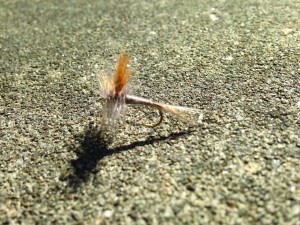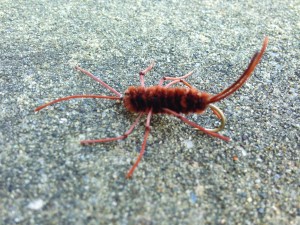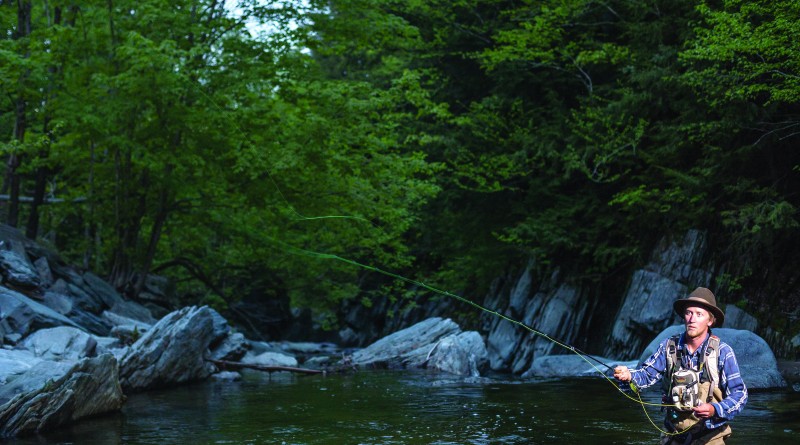Fly fishing the Hendrickson Hatch
By Weyland Joyner
MIDDLEBURY, VT. — My first experience with the Hendrickson hatch in Vermont was basically an accident. A saltwater angler by upbringing, I’d so far spent my first spring season in the Green Mountains casting incredulously and unsuccessfully at pocket water in meandering mountain tributaries, determined to prove to the internet fishing columns and well-meaning fly shop guys that real fish cannot, in fact, be found in the shimmering six-inch space between a gravel streambed and the water’s surface.
It had only taken me a few outings to get down to about two feet of leader and a last harried-looking Parachute Adams pirated from my grandfather’s mudroom closet. I headed to the fly shop, squaring my shoulders against the knowing smiles I knew I’d receive.
The next afternoon was overcast with a slight drizzle. From the handful of exotic new flies that had been foisted upon me I selected a #12 Sparkle Dun. As I rigged up I noticed bugs coming off the water. By the time I’d waded out to what seemed like a decent spot they were hatching in droves, the same light color as my new fly, and then—first sporadically, then increasing to a splashing frenzy—rises! Needless to say, what ensued was a dry-fly angler’s dream.
 Dialing in on a hatch can be a frustrating and time-consuming endeavor, but it yields much more than occasional great fishing. Insects are an integral part of riverine ecosystems, and learning their habits is one of the most rewarding ways to get acquainted with the rhythm of life on local waters.
Dialing in on a hatch can be a frustrating and time-consuming endeavor, but it yields much more than occasional great fishing. Insects are an integral part of riverine ecosystems, and learning their habits is one of the most rewarding ways to get acquainted with the rhythm of life on local waters.
As spring stutters its way into May, the time for Hendricksons is almost upon us. Here is what I’ve learned:
Hendrickson are a type of mayfly, one of three groups (along with stoneflies and caddis flies) of aquatic insects important to fly fishers and their quarry, trout. Mayflies begin life as nymphs—crawling subaquatic larvae. As water temperatures rise toward the mid-50s in May, these nymphs begin to wriggle their way to the surface of the water, a time during which they make up some 80 percent of a trout’s diet. Once a nymph reaches the surface film, it begins to shed its exoskeleton shuck, becoming, in fly fishing parlance, an emerger. When the mayfly has fully emerged and broken through the water’s surface film, it must wait to dry its wings.
The winged dun, so named for its dull color, flies to the riverbank for the night. There, it once again molts its skin, becoming a sexually mature spinner. By the way, these mayflies only live for about 24 hours from the time of their emergence, because in the transition from nymph to dun their digestive system has been exchanged for sexual organs—which is about as fatalistic and no-nonsense an evolutionary adaptation as I’ve ever heard of, and gives rise to the fly’s scientific name, Ephemerella.
The afternoon and evening of the day following their emergence, the males swarm over the water as females individually join them. After mating, the females deposit their eggs and drop, exhausted, to the water. This is what is known in fishing terms as a spinner fall, and is about the most profitable phase of the mayfly’s life cycle to fish. So: eggs, nymph, emerger, dun, spinner, fish food. Got it?

As anglers, this year we can look forward to higher, colder water in most of our river systems well into May in the wake of deep snowpack and heavy runoff. In muddy, turbulent conditions the best strategy is to dead drift or swing big, bright streamers to combat low visibility, but as water levels lower and streams start to clear up going into May, it’ll be time to tie on nymphs.
As long as the water is cold, fish will be lethargic, trying to conserve their calories, and won’t want to move to your flies. Try multiple dead drifts in fishy stretches of water, experimenting with different depths and flies. It may take putting your rig right on a trout’s nose to get its attention. Double nymph rigs double chances, so tie on a heavy beadhead nymph trailed at about 16 inches by a smaller wet fly. Flashy patterns are great for the early season, when fish haven’t been spooked by heavy fishing pressure. Another option is to tie a small mayfly nymph behind a big, meaty stonefly imitation like a Pat’s Rubberlegs.
Once the water hits the mid-50s, Hendricksons should start hatching in the afternoon. Overcast days tend to be best for catching good hatches. If bugs aren’t coming off the water but you still want to try to force a rise, tie a small, light nymph behind a big dry.
Fly shops generally carry plenty of Hendrickson patterns, and it’s always a good idea to check with the local shop to find out what’s working, but some of my all-time favorite patterns include Sparkle Duns, which are meaty and tend to sit nicely in the water, and plain old Hendrickson patterns, which tend to be a little slimmer and more heavily hackled. There are actually two varieties of Hendrickson dun, light and dark, so pick up a couple flies in each color. It’s also a good idea to bring some emerger patterns, which have a synthetic ‘shuck’ instead of a tail, and some spinners.
I’ve never stumbled onto a hatch as easily as I did that May afternoon, but every spring I look forward to seeing mayflies start to pop off the water as a sign of warmer weather and great fishing.


